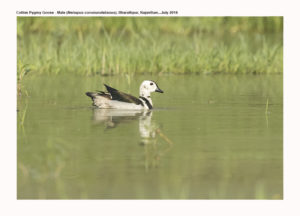Cotton Pygmy Goose (male) |

Cotton Pygmy Goose Nettapus coromandelianus
Etymology:
- Nettapus : Greek word netta – duck; pous- foot
- Coromandelianus : From Coromandel Coast, Karnataka in India
Vernacular Names: Sind: Baher, Kararhi, Hindi: Girri, Girria, Girja, Sans: Kaanuk hans, Pun: Chitti til, U.P.: Gurgura, Ben: Bali hans, B’ desh: Bhullia hans, Ass: Ghila hanh, Naher, Keeke, Chuwa, Guj: Giija, Mar: Ade, Atla, Kaanuk, Ori: Dandana, Ta: Kannadi cheravi, Te: Dudu chiluva, Kan: Bili baatu
Distribution in India: Widespread winter visitor.
Description: Size of 30–38 cm; wt. of male is 255–312 g, female 185–255 g ; wingspan is 57 cm. Breeding male is green above, with narrow dark breast band, dark crown, and white face, with all-black bill, grey-olive legs and feet, and crimson-red eyes. Adult female has obvious eye stripe, more extensive crown patch, dark brown eyes, brownish and yellow bill, brown back and more dusky underparts. Non-breeding male more or less like female but with more white on speculum and has whiter head. The juvenile resembles female but lacks iridescence and has a more distinct eyestripe.
Habitat:It is found in Well-vegetated, deep, freshwater pools, lakes and lagoons with much floating and submerged vegetation in tropical lowlands; also on marshes, flooded paddy fields, rivers and streams.
Food Habits: It eats seeds, grasses, and green parts of aquatic plants. Also eats Flower buds and invertebrates. Forages by dabbling and grazing among floating vegetation, typically flattening head onto water surface, filtering food while swimming and swallowing using occasional upward jerks of the head; rarely dives.
Breeding Habits: They breed in Nov-Feb. Monogamous and pair-bonds probably long-lasting. The nest is made in tree hollows with bottom lined with down feathers. The nest-site is selected by both pair members. They lay a clutch of 6–9 eggs. The incubation is done by female alone.